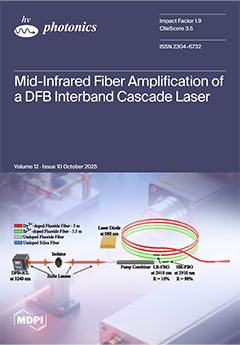This work shows that inverse Judd–Ofelt (JO) analysis of relative absorption spectra, anchored by a single lifetime, provides JO parameters and radiative rates without absolute calibration. The method is applied to Er
3+, Dy
3+, and Sm
3+ in a compositionally identical oxyfluoride glass. Three well-resolved ground-state 4f–4f absorption bands were selected. After baseline removal and wavenumber-domain integration, their normalized strengths
Srel,k (k = 1, 2, 3; k∈S) define a 3 × 3 system solved by non-negative least squares to obtain the anchor-independent ordering (Ω
2:Ω
4:Ω
6). Absolute scaling uses a single lifetime anchor. We report lifetime-scaled Ω
t and A
rad, and the normalized fractions
pk within the selected triplets; as imposed by the method, the anchor-independent ordering (Ω
2:Ω
4:Ω
6) is analyzed, while absolute A
rad and Ω
t scale with τ
ref. The extracted parameters fall within the expected ranges for oxyfluoride hosts and reveal clear ion-specific trends: Ω
2 follows Dy
3+ > Er
3+ > Sm
3+ (site asymmetry/hypersensitive response), while the ordering Ω
4 > Ω
6 holds across all ions (oxide-rich networks). Er
3+ exhibits the largest Ω
4 and the smallest Ω
6, indicative of pronounced medium-range “rigidity” with suppressed long-range polarizability; Sm
3+ shows the lowest Ω
2 (more symmetric/less covalent coordination); and Dy
3+ the highest Ω
2 (strong hypersensitive behavior). Uncertainty was quantified by Monte Carlo resampling of the preprocessing steps, yielding compact 95% confidence intervals; the resulting JO-parameter trends (Ω
2, Ω
4, Ω
6) and normalized
fk fractions reproduce the characteristic spectroscopic behavior known for each ion. This method enables quantitative JO outputs from uncalibrated spectra, allowing direct spectroscopic comparisons and quick screening when only relative absorption data are available.
Full article





